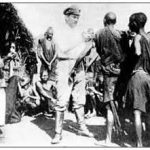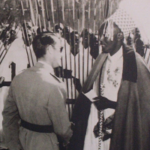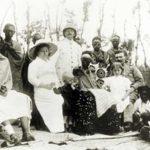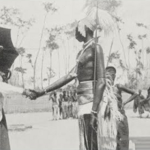Ubuhake
Under these conditions of growing personal insecurity, it is not surprising that ubuhake clientship became more widespread in Kinyaga. In Impara and Abiiru regions, people who had not been clients before, and whose fathers had not been clients, acquired patrons. Moreover, after Rwagataraka’s conquest of Bukunzi and Busoozo, the clientship institutions of central Rwanda were extended to those two regions as well. The process which had begun to gain momentum during the period of German rule, continued, whereby individuals who had not formerly been clients often found themselves obliged ta seek a patron.
Ubuhake clientship duringthis period took a variety of forms, but two major types can be distinguished. The first of these approximated the model of clientship most commonly associated with the Rwandan political system. Maquet, for example, assumed that all Rwandans were involved in ubuhake cattle clientship. This form involved the transfer of a cow from patron to client. The client, was entitled to the cow’smilk, and to the usufruct of the cow’s offspring. After the cow had given birth three times, the client sometimes would give the patron a female calf. Before receiving the ubuhake cow, the prospective client would in some cases give the patron a cow, but this occurred mainly when the client was of relatively high status in relation to the patron.
In fact, ubuhake cattle clientship never affected more than a small percentage of Rwanda’s population, but in Kinyaga, and in other regions of the kingdom, the number of clients did grow markedly during the first three decades of colonial rule; men of the generation living under the reign of Musinga (1897-1931) were more likely to adopt clientship than their fathers. Recent research by Saucier in Butare Prefecture, south of Nduga, has shown that the percentage of men there who received cows as ubuhake clients doubled during the colonial period; yet clients still did not exceed 17 percent of the adult male population and there was a significantly higher proportion of Tuutsi clients than Hutu. Saucier’s data show that ubuhake cattle clientship in earlier periods included only a small proportion of the population, certainly less than ten percent, at least in southem Rwanda. Although quantitative data from Kinyaga are not available, interviews there indicate that similarly low figures prevailed for the pre-European period, and that there was a marked growth of clientship in the early colonial period.
These data and the results of research by others seriously challenge earlier assumptions about universal clientship as a primordial institution, which served to integrate Rwandan society (and thus reduce barriers between ethnic groups). According to this perspective, cattle clientship was the principal cultural element forming an unvaried seamless pattern from top to bottom, a structure in winch everyone but the king himself was the client of another. But the evidence from Kinyaga and other areas now makes it clear that rather than seeking clientship, many successfully evaded it; and (at least in areas outside central Rwanda) cattle clientship grew significantly only with colonial rule. It is argued here that it was in part the very recent nature of ubuhake, and the increasingly involuntary nature of it, which contributed tothe depth of feeling against Tuutsi chiefs in mid-century.
The benefits for the client in ubuhake cattle clientship included the use of a cow. Where pasture was scarce an important “advantage” of the client tie was the right of the client to graze his cattle on the patron’s land. This would help to explain the high proportion of people who became clients in the area around Shangi-Nyamirundi. The disadvantages of this form of clientship included the danger of losing one’s personally owned cattle, should client ties subsequently be severed. A client was expected to visit his patron regularly and to carry out personal services for him. The very nature of the relationship was diffuse; the demands made at different times to the same or different clients could vary considerably. Some clients bore such humiliation as taking a beating in place of their patron, others worked as domestic help at the patron’s residence. More favored clients repaired the reed fence surrounding the patron’s homestead or carried his tobacco pouch and pipe during the daily round of visits.
A second form of ubuhake clientship differed frorn the first in that no cow was transferred from the patron to his client. Yet, although the client received no cow, he had a similar relationship to the patron and performed services similar to those required as in the first form of ubuhake clientship. Kinyagans refer to such clientship as guhakirwa ubutaka (to pay court for the land-land clientship). As might be expected, the patron in such a relationship was often the local hill chief
(later, subchief ), who controlled much of the land during this period. This type of clientship bore strong similarities to ubureetwa, but implied a special status for clients which ubureetwa did not convey.
Advantages for the client included higher status than simple cultivators who were constrained to ubureetwa service. In addition, a client sometimes gained protection against arbitrary actions by the hill chief. The disadvantages included the performance of services for the patron, but no corresponding usufruct of a cow. On the other hand, the patron, who had given no cow to the client, could claim no “legal” rights over any personal cattle the client happened to own.
The differences in the two forms of guhakwa described above help to illuminate more clearly the nature of such dientship. A major reason for seeking a patron was to protect one’s property and to preserve or improve one’s status. For patrons, ubuhake clientship provided greater control over individuals, assuring a following and services. Where transfer of a cow was involved, the patron obtained control over cattle, and ubuhake thus replaced umuheto clientship in some respects. For people who owned cattle, ubuhake clientship was a means of “protecting” that cattle. For those who did not own cattle, ubuhake could serve as a means of obtaining a cow to be used for bridewealth or for increased status; a cow was not an end in itself, but rather a means to a social goal. As more Kinyagans were drawn into ubuhake clientship, the character of client ties was modified. Status differences between clients and non-clients widened and the exigencies of protection increased, so that clientship became more necessary-and less voluntary; the element of coercion had markedly increased.
This more oppressive character of clientship was linked to three developments. The first was the gradual disappearance of the old form of umuheto clientship. We have seen that early umuheto clientship had provided protection for the cattle of Kinyagan lineages while requiring few services in return; moreover, the lineage fulfilled obligations to an umuheto patron in common, as a corporate unit, thus reducing the imposition on any single individual. Separated from the cohesiveness of the larger kin unit, the individual client had fewer political resources with which to face his patron.
A second factor was the extension of clientship to less powerful members of the population. Greater inequality in the relative positions of patron and client meant less negotiating power for the client.
Third (and most important), the penetration of the administrative system was more effective during this period. With greater concentration of political authority in the local hill chief and the provincial chief and the disappearance of alternative authorities, many people found it necessary to seek a favorable position vis-à-vis the chiefs. Consequently, there was a trend toward combining the position of patron with that of hill chief.
Under these circumstances, the dilemma of a potential client was severe. In considering whether to become a client of the local chief, a person owning cattle faced a difficult choice: should he resist the pressure to become an ubuhake client, he would thereby risk losing his cattle (and perhaps even his land), since cattle unprotected by a patron was regarded as fair game for powerful political authorities. Even if he were not deprived of his cattle and his land, he would be liable for assignrnent to ubureetwa work (if he were Hutu), and perhaps also to akazi or other undesirable tasks.
Should he request the protection of an ubuhake patron, probably his local subchief, he would gain protection for his cattle; no one wouId dare to deprive him of his cattle and risk the wrath of his patron. Moreover, should he achieve a favored client status, he would probably escape burdensome tasks, and be assigned to some of the prestigious functions of ubuhake clients, such as carrying the patron’s pipe and tobacco pouch. The disadvantage of the ubuhake bond, however, was the authority over the client’s personally owned cattle that the patron would aequire (in practice, if not legally). Once an individual had accepted a cow symbolizing his client status, the patron (the donor of the cow) assumed rights over ail of the client’s cattle, even those which, frorn the client’s point of view, were his own property.
The reasons why people entered into clientship during this period highlight the coercive character the relationship acquired. The most important of these reasons was the need for protection. But the need for protection arose from the political circumstances of the time. The increased power of the chiefs and their arbitrary use of this power created conditions of great insecurity; consequently the motivation to accept clientship often resulted from direct or indirect coercion. For example, Kaamuhanda, a resident of Murehe (Abiiru region) recounted that his cows were seized by Rwagataraka and he was forced to become a client of the hill chief, Rusasura, in order to repossess these cows.
When I complained to Rwagataraka that I had never received any cattle from Rusasura he told me that if I was unwilling [to become a client] they would take my cattle or imprison me. I had to recognize the new patron because I was threatened with losing both cows and the land given me by my father.
Subsequently Rusasura gave Kaamuhanda two cows, and the latter became an ubuhake client. The informant’s father, who possessed imbaata (personally owned) cattle had not been an ubuhake client.
A man at Shangi recounted a similar incident involving his great grandfather, who became a client to protect his personally owned cattle. This Kinyagan noted that it was commonly believed that if someone refused to accept the ubuhake cow, the chief would “kill” [attack or dislike)
A resident of Muramba [Cyesha region) explained why people accepted ubuhake clientship:
Someone who had no patron, but who had imbaata cattle would sometimes (lose these) through spoliation. They would take them all from him. They would seize him and even put him in chains. Someone who was client of a powerful patron, knowing that a certain person had cows, and that the person had no patron, would go and ask his patron to give him so-and-so’s cows. He would attack this person and appropriate his cows. One had to pay court (guhakwa) to protect any cattle which came from the gift of a friend.
Some of the diffictilties clients rencountered with their patrons are illustrated in the following examples:
A man at Nyamirundi explained that bis father Rubango, who owned some 400 cows, became a client of Rwabirinda to protect those cows. Later Gashuuhe, one of Rwagataraka’s clients, attacked a prominent member of the lineage, Nyamugura, seizing all his cattle and deposing him from his position as hill chief at Nyamirundi and as representative for the Akamarashavu (umuheto) group. Rubango also lost all his cattle in the affair. Nyamugura was arrested, bound, and mistreated, and he eventually died as a result. The case is well known in Kinyaga, since Nyamugura was one of the few Hutu hill chiefs at the time. He was attacked “because he was rich; and they disliked rich men.
Birara, father of an informant at Shangi, obtained more than 25 cows with money he received from a German who had married his sister. He became an ubuhake client of Seekabaraga in order to protect these cows. Birara’s brother, Mutengeri, was attacked by Ntaabukiraniro (younger brother of Seekabaraga) because he did not want to become a client. Mutengeri, a strong blacksmith, resisted and succeeded in driving away Ntaabukiraniro’s men; they took three cows from him, but Mutengeri kept the rest. This incident occurred while P. Dryvers was A.T. at Cyangugu (late 1920s or early 1930s).
At Rukunguri in Abiiru, a certain Rubaba became a client of Gisazi to protect his three cows; had he not become a client, he would have risked losing the cows. And Seekayanje, grandfather of a Kinyagan in Abiiru region, lived at Mururu when Rubago was hill chief there. Seekayanje found it necessary to become a client of Rubago because the chiefs and patrons at that time “were like robbers.” The man named three members of his lineage who had been arrested and had their belongings seized.”
An account by Mudaage asserts that such conduct by chiefs was a general phenomenon, with but few exceptions:
With the exception of Mugenzi son of Nkombe and Nyankiiko, “all the other chiefs would come with a young small heifer and would give it to you supposedly as a sign of friendship. Then for some little fault, [the chief] would take all your cows, saying that all of them had come from him.
Not only was coercion a common stimulus to entering ubuhake clientship, it also often characterized subsequent relations between the patron and client. Some of the difficulties inherent in having a hill chief for patron are dramatized in an account by Munda, a resident of Nyamirundi hill in the Impara region.
Munda’s ubuhake patron was Kajonge, the local hill chief. When Kajonge was deposed by Rwagataraka, all his cattle were seized, including the cow he had given Munda, and Munda’s personal cattle as well. To recover his cattle, Munda became client of Mukimbiri, who succeeded Kajonge as hill chief and thus had received Kajonge’s cattle. Mukimbiri was later deposed. Munda then became client of Seemuhunyege, Mukimbiri’s successor. When Seemuhunyege was deposed, his successor Birikunzira became Munda’s patron. But Birikunzira seized Munda’s cattle (including two cows Munda had received from Seemuhunyege). After taking his case to the king, Munda was reinstated as Birikunzira’s client. But when he returned to Kinyaga, Birikunzira again seized his cattle.
Munda’s experience points to a common pattern in clientship to the hill chief: When a patron-chief was deposed or transferred, the client
would normally become client of the chief ‘s successor. Since the turnover of hill chiefs came to be fairly frequent, a client often went through several different patrons. This practice weakened the importance of affective ties between patron and client, and under these conditions little remained of the former personal alliance character of clientship.
Kinyagans quite rightly perceived that clientship was becoming increasingly identified with the administration. Indeed the importance which Belgian colonial authorities placed on the ubuhake ties of provincial chiefs only confirmed that perception. As the two networks-administrative hierarchy and clientship ties became more closely integrated a chief’s client ties outside his own administrative domain were seen to compromise the integrity and effectiveness of administrative structures. Hence in Kinyaga and elsewhere in Rwanda during the 1930s, the European administration instructed chiefs to terminale ubuhake links to clients outside their chiefdoms. Rwagataraka’s many client linkages outside his “official” domain now represented irregular channels of administration, as noted in a 1937 report:
The chief Rwagataraka has continued his intrigues and his efforts to meddle in the affairs of provinces which are no longer under his authority. His major means of intervention was concluding cattle contracts with “clients” residing outside the Impara and Bukunzi [provinces]. Measures have been taken to have these [contracts1 rescinded.
And in 1938: Rwagataraka has continued his sordid intrigues, rendering the
situation difficult for certain of his colleagues.
https://uk.amateka.net/ubuhake/https://uk.amateka.net/wp-content/uploads/2020/08/blg2.jpghttps://uk.amateka.net/wp-content/uploads/2020/08/blg2-150x150.jpgChanges and ColonialismUnder these conditions of growing personal insecurity, it is not surprising that ubuhake clientship became more widespread in Kinyaga. In Impara and Abiiru regions, people who had not been clients before, and whose fathers had not been clients, acquired patrons. Moreover, after Rwagataraka's conquest of Bukunzi and Busoozo, the...BarataBarata rpierre@ikaze.netAdministratorAMATEKA | HISTORY OF RWANDA




